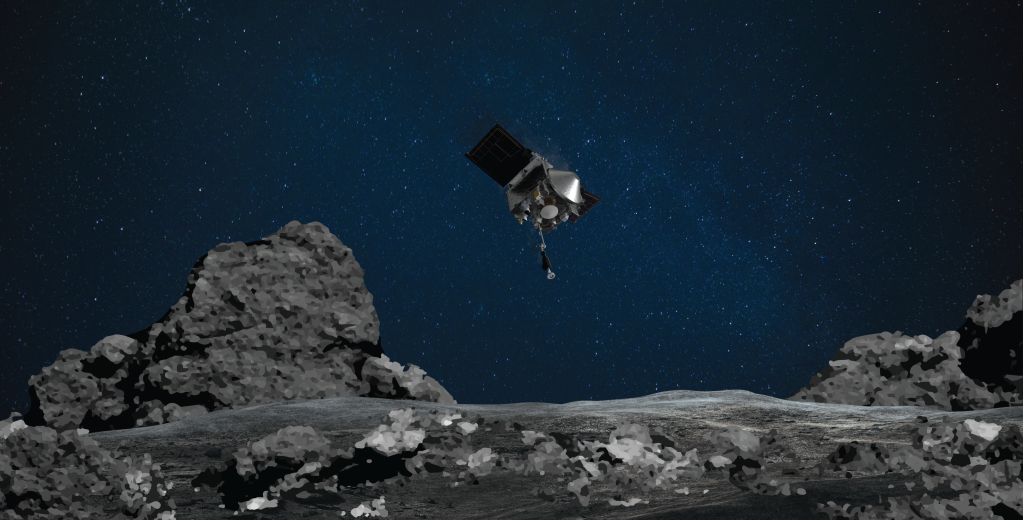A NASA spacecraft yoinked some dust and pebbles off the surface of an asteroid on Tuesday night, after orbiting the ancient space rock for nearly two years.
The achievement marks the first time that an American space probe has collected material from an asteroid and puts the mission on track to return the valuable sample to Earth in three years.
Videos by VICE
Launched in 2016, NASA’s Origins, Spectral Interpretation, Resource Identification, Security, Regolith Explorer, or OSIRIS-REx, reached its target, an asteroid named Bennu, in 2018.
Measuring about half a kilometer in diameter on average, Bennu is a dark carbonaceous asteroid that hails from the early solar system some 4.5 billion years ago. It is also a potentially hazardous object; scientists think there’s a one in 2,700 chance that it could hit Earth at the tail end of the 22nd century. These characteristics make Bennu an interesting destination for both scientific research and planetary defense.
“This was an incredible feat—and today we’ve advanced both science and engineering and our prospects for future missions to study these mysterious ancient storytellers of the solar system,” said Thomas Zurbuchen, associate administrator for NASA’s Science Mission Directorate in Washington, in a statement.
“A piece of primordial rock that has witnessed our solar system’s entire history may now be ready to come home for generations of scientific discovery, and we can’t wait to see what comes next,” he said.
Touching the surface of an asteroid is a milestone for NASA in itself, but it will take a day or two for mission leads to determine whether OSIRIS-REx was able to scoop up an adequate sample from Bennu. If the Touch-and-Go (TAG) maneuver didn’t snag at least 60 grams of material, the team may schedule another collection attempt in January.
“Our first indication of whether we were successful in collecting a sample will come on October 21 when we downlink the back-away movie from the spacecraft,” Michael Moreau, OSIRIS-REx deputy project manager at NASA’s Goddard Space Flight Center in Maryland, said in NASA’s statement. “If TAG made a significant disturbance of the surface, we likely collected a lot of material.”
Regardless, the probe should be prepared to kick off on its return trip, with its small cache of precious cargo, around March 2021. It is currently scheduled to return to Earth in September 2023. Once it’s close enough to home, OSIRIS REx will drop off the sample return capsule containing the primordial dust and stones, which will deploy parachutes and aim for a landing at the Utah Test and Training Range.
Though OSIRIS-REx is the first U.S. attempt to capture a sample from an asteroid, Japan has already achieved this feat twice. In 2010, the nation’s Hayabusa probe successfully delivered dust samples from an asteroid named 25143 Itokawa to Earth. Its successor mission, Hayabusa 2, is currently on its way back to our planet with material from another asteroid, 162173 Ryugu, which is on track to be dropped off in December.
And while this is NASA’s first asteroid sample return mission, the agency has previously snatched samples from a comet, Wild-2, as part of its Stardust mission. Stardust did not land on the comet, but was able to collect dusty grains from its coma, or atmosphere which, in 2006, landed at the same Utah site that OSIRIS-REx will target.
For most of human history, we’ve had to rely on lucky events, such as meteorite impacts, to bring extraterrestrial materials to Earth. Missions such as Hayabusa and OSIRIS-REx are now demonstrating the value of traveling to alien worlds in our solar system and biting off chunks for further research at home.
More
From VICE
-

YouTube -

Home Alone (Credit: 20th Century Fox) -

Adobe in ChatGPT (Credit: Adobe) -

Andrey Rudakov/Bloomberg via Getty Images
